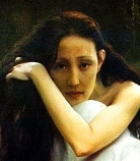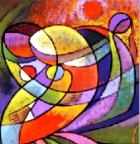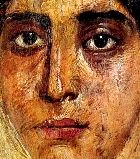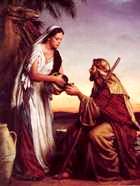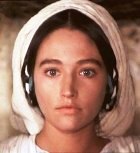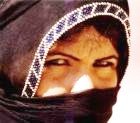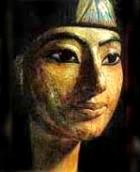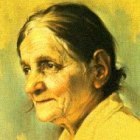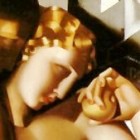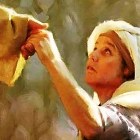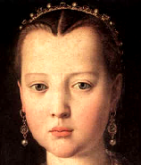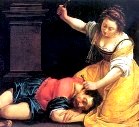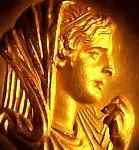Why bother about women in the Bible?
First of all, the stories are wonderful. They are wise, true, funny, tragic. They may be about other people, but they tell us about ourselves. The Bible women have families whom they love and fight with. They are funny, work hard, quarrel with each other, are unselfish, clever, noble, far-sighted, bossy, brave, frightened . . . all the things we ourselves can be.
Stories like ours
Ancient history? But the stories have a timeless quality that makes them sit comfortably in any period of history. Look at the stories of
- Ruth, a migrant woman from a foreign country adapting to a new land
- Sarah and Hagar, locked into a relationship which appears to be failing
- Rebecca, steering the men in her life into sensible decision-making;
- Mary of Nazareth, trying to understand the actions of her son or
- Martha and Mary of Bethany, working out what a woman’s role should be.
All of them have the same kind of problems that we face today.
Was their society like ours?
No, not really – not if you’re a woman in paid employment outside the home. The women and men of ancient Israel tended to work separately. They had separate roles – and separate stories too.
But at various critical points in Israel’s history the Bible was edited – edited by men. Most of the women’s stories were left unrecorded.
At the time this didn’t matter. This was a story-telling society which kept its memories alive by constantly telling and re-telling.
But over time the women’s stories were forgotten and lost. For a dramatic example of this, see the Songs of Miriam and Moses in Exodus chapter 15. The poem goes on and on about how wonderful Moses and Moses’ God is – then we get one verse about Miriam!
There would originally have been much more about Miriam – but her song is lost. So it is with most of the women’s stories.
What sort of work did women do?
Women were important. They were part of the economic life of the whole community, generating income and providing essential services. Look at the job description of a woman in biblical times: the tasks are surprisingly similar to the work a modern woman might do.
Judging from Proverbs 31:10-81, women aimed to:
- provide items of clothing, for their families but also for sale, as income for the family — the equivalent of paid employment (verses 13,19,24)
- administer the finances of the family and oversee the family business (v.16)
- buy and supervise investments for the family, make profits and re-invest them (v.16,18)
- perform charitable works (v.20)
- organise the household and keep it running smoothly (v.15,27)
- dress well and look attractive (v.15,27)
- be physically fit (v.17)
- give religious instruction to the children (v.28)
- make sure the family got a varied diet (v.14).
Then as now, the hours of the day were probably too short for all the work that a woman had to do.
So why do we see images of Mary quietly weaving while Joseph works in his carpentry shop? Because they reflect a medieval fantasy, not the real Jewish world.
In fact, the historical Joseph probably travelled to nearby Sepphoris, where work was readily available.
Mary was a robust peasant woman. She would have worked the family piece of land, and been responsible for running the household.
What rights did biblical women have?
Jewish women had complete authority within the home, and in matters governing the family. This was their sphere of influence, and the idea was built into Jewish law and religious ritual.
If you look at the story of Sarah and Hagar, you will find that God tells Abraham he must do what Sarah tells him in regard to slaves who work in the household.
What does this mean? It means that Sarah has authority over household slaves because she was the senior woman in the tribe, and everything in the entire household, including ownership and treatment of slaves, was under her jurisdiction.
Jewish women then, as now, had the responsibility of transmitting the “Jewishness” of the family. They were in charge of the education of the children up to the age of seven. Women were expected to teach their children all the stories and religious practices of Jews in those first seven years.
It is interesting to think that Jesus learnt the basics of his teachings from Mary when he was a young child. Women were entrusted with this task because they were seen as inherently more religious, more spiritual, than men.
- Women supervised the complicated food laws essential for a good Jewish family.
- They also headed the religious liturgies in the home. Men were in charge of synagogue worship; women were in charge of the important Jewish liturgies in the home.
Women could not be priests but then neither could most men: the priesthood was an hereditary role restricted to the men of one of the 12 Jewish tribes, the tribe of Levi.
How are Old Testament women relevant?
In almost every story related in the Old Testament you can find something to interest and inspire you.
Here are some examples . . .
- Ruth and Naomi (Book of Ruth): They were two friends/relatives who supported each other in good times and in bad. It did not matter that they were from different generations. They helped each other – the older woman advising, the younger woman acting with determination — so that both benefited.
- Deborah (Judges 4:1-16, 5:1-23): She gives us a model of intelligent leadership. She knew she could not do it all, so she delegated, and inspired the people around her to act beyond their limits.
- Eve (Genesis 1-3): Her story shows that men and women are incomplete without each other, and that there needs to be a balance of male and female qualities in each person if we are to reflect the harmony of God.
- Sarah and Hagar: (Genesis 13; 16; 17:1-8, 15-21; 18:1-15; 21:1-14): Barreness, rivalry and jealously shape Sarah’s cruel mistreatment of Hagar. Yet through the extraordinary mystery of God’s intervention in the lives of these two women, neither is lost; God’s plans and promises are gradually fulfilled.
What about women in the gospels?
The gospels have many stories about women, that’s true. But the purpose of the stories is different. They are about Jesus – he is the central focus – and not so much to tell us about the women themselves.
Moreover, the New Testament stories are set in a world different to the Old Testament.
- Israel was no longer its own master: it was occupied by Roman forces. Its world was volatile.
- And importantly, it was deeply influenced by Greek culture and Greek ideas.
The Greek influence had a profound effect on the way women were viewed. The status of women in the Greek world was low — because they were seen as being closer to the animal world than men. The Greeks believed that women were unfit to make their own decisions because they were irrational by nature.
What about Jesus and women?
Jesus obviously disagreed with the Greek line of thinking. Judging by the Gospels, his mother Mary seemed to have been a strong-minded woman, the primary influence in his young life. He probably related to women as he found them and the ones he knew were intelligent, confident and brave.
His relationship with women and the teachings that stem from this, are a firm “No” to the denigration of women that was inherent in Greek culture.
His dealings with women make it clear that he considered them equal with men in dignity and ability. Look at the women with whom he chose to associate:
- Mary Magdalene (Matthew 27:55- 61, 28:1-10, Mark 15:40-41,16:1-11, Luke 8:1-3, 23:49-56, 24:1-11, John 9:25, 20:1-18): She was the leader of the women followers of Jesus. She was there in his ministry, at the crucifixion, at his burial, and on the morning of the resurrection. She was the key witness of this earth-changing event. On that morning, Jesus told her to “go and tell” the others what she had seen (word for “go and tell” in Greek is “apostellein”).
- Martha and Mary of Bethany: (Luke 10:38-42, John 11:1-44, 12:1- 8): These two sisters had very different personalities, almost like two sides of a coin. One was a thinker, one was a doer. Jesus saw both these activities as essential: it is good to learn, but then we have to act as well.
- The Samaritan Woman: (John 4:1-42): Jesus talked to her as an equal. He listened to her ideas, and debated them. She too was commissioned to “go and tell”, and like the male apostles, she dropped everything (in this case, her water-jar) to spread the word about Him. Her story makes a strong statement about the contribution women were making in the early Christian communities.
- The Crippled Woman: (Luke 13): Her story is about hope. She is condemned by her infirmity to be bent and twisted, to always look downwards. With Jesus’s help, she raises herself so that she stands upright, able to look the world in the face.
There would have been hundreds of incidents and stories about Jesus and the many different women he met during his life. Yet only a few of these could be recorded.
Ask yourself why a particular story was important enough to form part of the Gospel.
- What did the storyteller want to pass on to the people who heard that story?
- What may have been left out?
- Does the story tell us something about ideas swirling around in the early Christian communities?
Discussion Points
There are many activities and discussion points which can come out of these stories.
Old Testament
- Sarah and Hagar: Look up Deuteronomy 23:15-16, on the treatment of slaves, and find out what you can about slaves in the ancient world. Then ask yourself this question: how different is modern wage slavery to ancient slavery?
- Tamar: Find out about groups which help Women/children/families in crisis. What services do they offer? Can you help them in any way?
- Rebecca: She is one of the great heroines of the Bible. Look at the films and books you have seen or read recently. What qualities do modern heroines have? How do they compare with biblical heroines?
- Miriam: What are the qualities of a good leader? In community activities; in national politics; in the workplace?
- Hagar: Find out about Hagar’s importance to Islam.
New Testament
- Invite a guest from the Jewish community to speak on the customs and beliefs of Jewish women today.
- Mary of Nazareth: Mary is probably the most famous mother in human history! If you can, interview your own mother, and ask her about her life. What are the events she remembers best? What are the things she is proudest of? Found the most difficult? What are her memories of religious practice during her life?
- Mary Magdalene: She organised and carried out the preparations for Jesus’ burial. What are your own experiences of illness or death among friends and family? What do you think of present-day arrangements for coping with death and grief? Are there ways they could be improved?
- The Woman of Samaria: The woman in this story experiences the progressive stages of faith in Jesus. She meets Jesus, she learns about him, and she comes to believe in him. Then she goes and tells other people about him. Are there parts of this story which are like your own story? What has been your own experience?
If you are thinking of reading some of the stories about women in the Bible, why not try some of the lesser-known ones?
- Michal, royal princess and queen, 1 Samuel 14:49, 18:17-29, 19:11-17, 25:43-44, 2 Samuel 3:12-16, 6:12-23
- Jael, a woman who fought with the weapons she had, Judges 4:12-24, 5:24-27
- Hagar, the slave woman of Sarah’s household, Genesis 16:1-16, 21:1-21
- Bathsheba, queen and queen mother, 2 Samuel 11:1-27, 12:1-25, 1 Kings 1:1-140, 2: 13-25
- Tamar, ancestress of Jesus, Genesis 38:1-30 (see ancestresses of Jesus)
Read the stories for interest, for their human value, and try to understand the Women.
- What were their motives?
- What sort of personalities did they have?
- Would you have acted differently in their situation?
Most importantly as you read these stories, enjoy exploring them. Don’t go looking for moral messages. They are there, but you will have a better chance of discovering them if you see them through and in the people who live within the pages of the Bible.
Search Box
![]()
Women’s stories
© Copyright 2006
Elizabeth Fletcher

